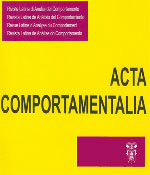Efeitos do treino de discriminações condicionais sobre a aquisição de relações simétricas e transitivas
Contenido principal del artículo
Resumen
O presente estudo analisou experimentalmente os efeitos do treino de relações condicionais (e.g., AB e BC) sobre a aquisição de suas relações simétricas (BA e CB) e transitivas (AC e CA). Foi empregado um procedimento de pareamento arbitrário ao modelo envolvendo nove conjuntos (A-B-C, A’-B’-C’ e A”-B”- C”), cada qual com quatro estímulos. Quatro participantes adultos foram submetidos a um treino de 48 relações condicionais que compuseram três grandes grupos. Do Grupo I, foram treinadas todas as 24 possíveis relações condicionais estabelecidas entre os estímulos dos conjuntos A-B-C, ou seja, as relações AB e BC e suas correspondentes relações simétricas (BA e CB) e transitivas (AC e CA). Do Grupo II, foram treinadas somente as oito relações A’B’ e B’C’. Do Grupo III, foram treinadas somente as 16 relações B”A”, C”B”, A”C” e C”A”. Dessa forma, em condições permanentes de reforçamento, avaliou-se comparativamente a aquisição de relações condicionais na presença (Grupo I) e na ausência (Grupos II e III) do treino de relações simétricas. Os resultados mostraram que as relações condicionais treinadas juntamente com suas contrapartes simétricas (Grupo I) foram aprendidas mais rapidamente e com menor acúmulo de erros do que as relações condicionais treinadas na ausência de tais contrapartes (Grupos II e III). Efeitos semelhantes não foram sistematicamente verificados sobre o treino de relações transitivas, sugerindo, assim, a existência de variáveis distintas no controle do responder simétrico e transitivo. Esses resultados sugerem alternativas metodológicas a serem aplicadas em condições nas quais discriminações condicionais sejam avaliadas na ausência de reforçamento.
Detalles del artículo
Cómo citar
Missiaggia Velasco, S., & Yukio Tomanari, G. (2010). Efeitos do treino de discriminações condicionais sobre a aquisição de relações simétricas e transitivas. Acta Comportamentalia: Revista Latina De Análisis Del Comportamiento, 17(1). Recuperado a partir de https://revistas.unam.mx/index.php/acom/article/view/18143
Citas en Dimensions Service

<a rel="license" href="http://creativecommons.org/licenses/by-nc-sa/4.0/"><img alt="Licencia de Creative Commons" style="border-width:0" src="https://i.creativecommons.org/l/by-nc-sa/4.0/88x31.png" /></a><br />Este obra está bajo una <a rel="license" href="http://creativecommons.org/licenses/by-nc-sa/4.0/">licencia de Creative Commons Reconocimiento-NoComercial-CompartirIgual 4.0 Internacional</a>.
